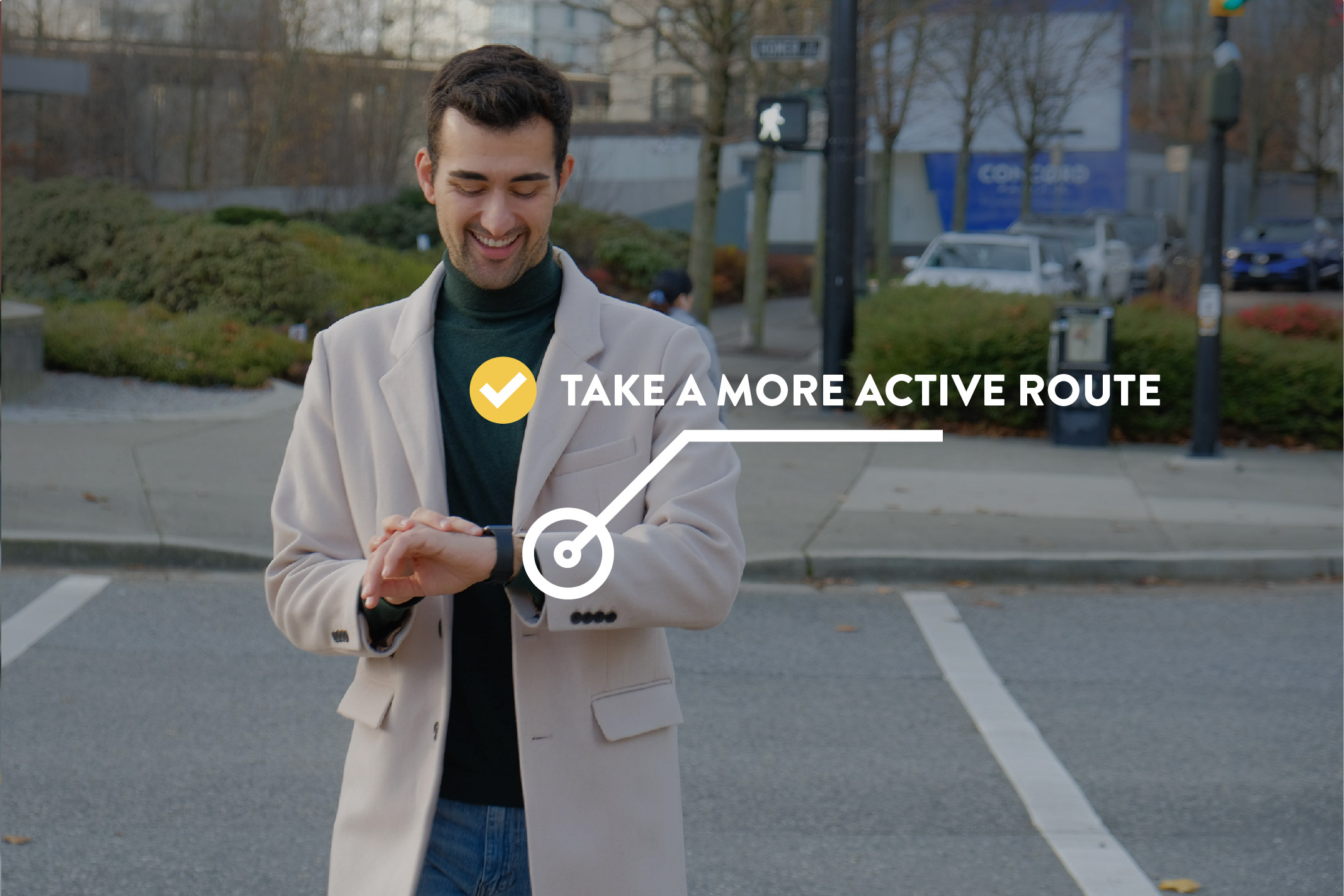What is your thought pattern when you need to go somewhere? Getting there quickly. How can you be most efficient in getting to where you’re going? The fastest route. Check Google. Looks like Uber is fastest to get home tonight. Door to door. Done.
But what if the most efficient thing to do was actually to take a slightly longer and more active route?
Why A-to-B is not the A-to-B for health
Time is the number one reason our clients give us for not being able to fit physical activity into their day. They’re too busy to get to the gym for a workout, or the studio for a spin class, or to take 5 minutes to meditate. Just not enough time in a day they say [1].
For clients who say their time is crunched this is the perfect habit because it isn’t something new they’re introducing to their already packed schedule—it’s something they’re just modifying to become a little bit healthier. By changing the way they view their daily commutes, trips to the store, or jaunts around town, they can transform simple errands into easy ways to sneak in some calorie-burning movement. If they try hard enough, they might even create some space in their day for some active meditation.
Every great journey starts with a single step
While the habit of taking a more active route has some overlap with the commonly recommended health goal of increasing your steps taken in a day (most Americans only get 5,000-7,000 of the recommended 10,000 daily steps [2] [3]), the habit of taking a more active route has a slightly different purpose.
Instead of looking solely at bumping up your end-of-day pedometer count, this habit looks for ways to convert sedentary methods of transportation into more active options. For example, instead of driving somewhere, riding your bike. Or instead of taking the bus, walking. The amped-up step count will be an obvious byproduct of these changes but, at the end of the day, we aren’t worrying about what the pedometer says.
Teaching your clients to walk before they run
You may have some clients stare at you wide-eyed at the suggestion they bike or walk to work instead of drive—and sure, maybe hoofing it isn’t always an option! Some people will work too far from home for this to be feasible, but you can still find other opportunities for them to take a more active route or even just bump up the amount of movement in their daily commute.
For example, maybe your clients still drive to work but instead of parking in the closest spot to their destination, they park a couple of blocks away or at the farthest corner of the parking lot. They can apply this both on their way to work and when they’re heading home.
By adding a 5-minute walk to your parking from your house to your car, then from your car to your work (x2 ways), your client will have added 20 minutes total walking time to their day! That amount of added walking closely amounts to about 100 calories of energy expenditure [4]!
Coaching your client to seek out the active route
This habit like most is going to take some brainstorming and support. You’ll need to chat with your clients to provide examples of how they can ditch their direct route and up their activity.
Help them figure out what specific actions they can do day-to-day. Are there stairs up to their office they can take? Where do they currently park? Is public transportation a possibility for their commute (usually, stops are further away from destinations and more walking is required)? Is it possible logistically to ride or run to work?
Whatever you discover with your client, be sure to pick something that is specific (the activity and the time they’ll complete the action), and attainable. Most challenges/failures will occur from ambiguity in the task or something that is unrealistic for your client. Be sure to set them up for success!
Taking a more active route in a nutshell:
- An active route is more than just walking further, it’s finding a way of getting from point A to point B that expends more calories than one’s current habitual route.
- Sometimes this means the trip will take longer, but not always.
- Efficient use of time to expend calories and get somewhere.
- To coach this habit, you will first need to brainstorm and set specific actions and times to complete these new more active routes.
References:
- https://www.barstoolsports.com/barstoolu/new-study-shows-the-top-ten-reasons-why-americans-dont-work-out
- Berko J, Goetzel RZ, Roemer EC, Kent K, Marchibroda J. Results From the Bipartisan Policy Center’s CEO Council Physical Activity Challenge to American Business. J Occup Environ Med. 2016;58(12):1239-1244. doi:10.1097/JOM.0000000000000897
- Bassett DR, Wyatt HR, Thompson H, Peters JC, Hill JO. Pedometer-measured physical activity and health behaviors in U.S. adults. Med Sci Sports Exerc. 2010;42(10):1819-25. doi:10.1249/MSS.0b013e3181dc2e54
- https://www.livestrong.com/article/320124-how-many-calories-does-the-average-person-use-per-step/

